Course:FNH200/2014w Team19 Nutella
Nutella
How often do you find that you regularly open up a jar of creamy Nutella to spread it over your toast, and end up eating about half of the jar yourself? Don't worry, there are millions of people who are in the same boat. But how can you blame yourself? Nutella is an irresistible, decadent spread that pleases the palates and provides the essential nutrients. So next time you see Nutella, go ahead and indulge! Just remember that moderation is key, whether it be two tablespoons or half a jar!
History

Before Nutella, there was Gianduia [1]a chocolate and hazelnut paste that became popular in the 1800s across Italy. Many companies first began creating this spread in the Piedmont region of Italy.[2]. Caffarel was one of the major companies to produce Gianduia. But why Gianduia? Gianduia was first a stock character in a 16th century Italian comedy, but now is the face of the Piedmont region [1].
In 1852, Caffarel changed the Gianduia product and began to sell "Gianduiotto"; essentially, it was a chocolate bar shaped like an upturned boat [1] [2]. Besides the chocolate bar, the Gianduiotto was the second solid chocolate product. Why include hazelnuts? There are many reasons, but the main ones are that hazelnuts give the product a less bitter taste than solid chocolate, and because hazelnuts were cheaper to use than cocoa powder; thus, it was therefore more appealing to customers [1].
In the 1940’s, a pastry maker by the name of Mr. Ferrero comes up with a smart idea “to extend the chocolate supply.” In order to do so, he used a small amount of chocolate, as cocoa powder was very expensive during World War II, and larger amount of hazelnut (due to its availability and lower price compared to cocoa powder) to produce a chocolate paste that later became known as Nutella.[3] [1]
The very first available version of Nutella, called “Pasta Gianduja,” was in the form of loaves and wrapped with foil [3].

However, Ferrero decided to change the product to something that would be easier to spread on bread. He changed the product from a more solid, loaf-like product to a creamier, spreadable product in a jar [3]. With the product change followed a name change, from “ Pasta Gianduja” to “Supercrema Gianduja.”[3] In 1964, this product renamed to Nutella [3]. The origin of this word consisted of it originally starting off with “nut,” and “ella” was added to the ending to give it a “soft ending.”
The reason Nutella became increasingly popular (and rather quickly too) during World War II was it gave people the opportunity to enjoy chocolate without spending too much. During those days, one kilo of chocolate was 6 times the cost of a kilo of Pasta Gianduja. [4] Nutella became more famous as time passed in Italy, and it quickly became a staple in the breakfast of many Italians; shortly thereafter, Nutella became part of the Italian tradition [4]. So that, Mr Ferrero decided to spread their Italian tradition to United State in 1983 and short after that to the whole world. Nowdays, Nutella with its unique formula, “roasted hazelnut, skim milk, hint of chocolate”, become famous among everyone that “in every 2.5 seconds one jar of Nutella is sold around the world.”
Ingredients
Based on what listed on the Canadian Nutella label the ingredients are as follow [3]:
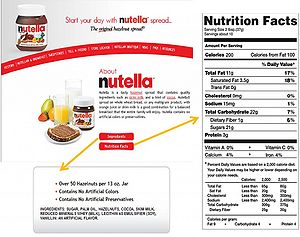
- Sugar
- Palm Oil
- Hazelnuts
- Cocoa
- Skim Milk
- Reduced Minerals whey (milk)
- Lecithin (soy)
- Vanillin
Ingredients Breakdown
Below, we take a closer look at the list of ingredients and what the purpose/function of each ingredient is [5]:
- Sugar: the very first ingredient mentioned on the label is sugar and that means the majority volume of Nutella is sugar , 11 grams of sugar in every 19 grams of Nutella. Sugar mainly used as sweetener but can also use as flavor agent.
- Palm Oil: is a kind of vegetable oil that is semi-liquid. In Nutella palm oil used to give spreadable texture. At the beginning Nutella have made with hydrogenated oil but later in 2006 Nutella reformulated and palm oil added to the formula because it is free of trans fat.
- Hazelnut: Give Nutella its taste.
- Cocoa: this brown powder gives Nutella the taste and color of chocolate.
- Skim milk: used to give Nutella some viscosity and texture.
- Reduced mineral whey (milk): It is commonly added to stabilize fat emulsions and prevent coagulation. As well, this incorporates some minerals into Nutella (such as Iron and Calcium)
- Soy Lecithin: is similar to whey powder and is used as emulsifier that keeps sugar, oil, nuts and cocoa together and stops them from separation.
Manufacturing
Ferrero Canada's main production plant is located in Brantford, Ontario and supplies all of North America with delicious Nutella [6]. The process of making this unique spread begins with the selection of cocoa beans, which are left to dry for ten days before transporting them worldwide to the Nutella manufacturing facilities [7]. The Ferrero Company has established the goal of sourcing 100% sustainable cocoa by the year 2020 and to achieve independent and reliable third-party verification of its cocoa sourcing [8]. Upon arrival to the plant, the beans are roasted; this is because they consist of 50% cocoa butter, and high-temperatures aid in reducing the cocoa beans into a liquid paste [7]. The paste is then sent to a presser that squeezes out every last bit of the liquid butter, and sends out 7 kg discs of pure compressed cocoa powder [9].
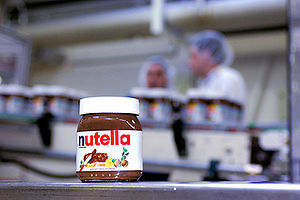
The next step is the addition of hazelnuts. To ensure uniform taste and quality, the hazelnuts undergo two different quality control tests [7]. After going through the first quality control station, the hazelnuts are processed. They all head to the ovens to be roasted; a computer-controlled machine removes any poor quality nuts [7]. They are joined by the cocoa powder, sugar, vanillin (used to enhance sweetness of chocolate), skimmed milk, whey powder, lecithin, and palm oil in a tank where they are mixed into a smooth paste [7]. The whey powder acts as a stabilizer in fat emulsions, and lecithin is used to emulsify and aid in providing the spreadable nature of Nutella [7]. Ferrero has achieved the 100% goal supply of certified sustainable palm oil by 2014. The current palm oil requirements of the Ferrero Group are approximately 150,000 tonnes per year, acquired from Malaysia, Papua New Guinea and Brazil [8]. After all of the ingredients are mixed, Nutella is ready to be packaged.
Packaging
The Nutella jar is made of PET (Polyethylene Terephthalate) and the lids are made from polypropylene material, both of which can be recycled [8]. The process of making PET plastic bottles begins with an automated mixer that combines PET palettes with flakes of recycled PET. Because recycled materials lose some of their original properties, the recycled content cannot exceed 10% [10]. The PET falls from the mixer into a plastic injection machine that heats it up to 315 degrees Celsius. This melts the material into liquid plastic, which the machine then shoots into a mould at high pressure to create something called “pre-forms” [10]. Pre-forms are the general starting shapes that machines will then transform into the desired shape of the various types of jars [10]. The pre-forms hardened instantly thanks to a built-in cooling system. The pre-forms will then be transferred to a machine called a “re-heat stretch blow moulder” that heats each pre-form to a certain temperature, as this makes the plastic malleable. A rod is inserted into the pre-forms, which simultaneously stretches the pre-form lengthwise while at the same time blowing in air at high pressure that forces the pre-form into the desired shape [10]. Cold water circulates within the mould to set the plastic almost instantly. Samples are pulled for quality control tests, thickness, strength, and resistance are evaluated [10]. When the jars are ready, they are passed under pipes and filled with Nutella. The final step is sealing each jar. Within each Nutella lid there is an air-tight seal which gets attached to each new jar after the jars have passed through a machines that paves a layer of glue onto the rim [9]. When the lids are added, the glue traps the seal and Nutella jars are ready [9]. They are palletized and shipped across North America.
Labeling and Standards
In Canada, food and beverage labelling requirements are outlined in the Canadian Food and Drug Regulation Act and are enforced by the Canadian Food Inspection Agency. According to the Act, all food labels in Canada must be written in both French and English and contain the following information [11]:
- Common name
- Net weight
- Ingredients (listed largest to smallest proportion)
- Durable life date
- Nutritional facts table (including Calories, amount of fat, saturated and trans fats, cholesterol, sodium, carbohydrate, fibre, sugar, protein, calcium, iron and Vitamins A and C)
- Name and address of the manufacturer
Additional Labelling Requirements for Nutella
According to the Consumer Packaging and Labelling Act and Regulations, Nutella is considered a pre-packaged food product, which the Guide defines as “any product that is packaged in a container in such a manner that is ordinary sold to or used or purchased by a consumer without being re-packaged.” [12] Nutella labelling must also state that it contains hazelnuts, and must also include it in the list of ingredients. [13] According to Health Canada, tree nuts are one of the top ten priority allergens in Canada, and because of this, manufacturers must alert consumers to their presence in a specific food product. [13] According to Canadian Food Inspection Agency, Nutella is classified as an unstandardized hazelnut spread. Nutella and other unstandardized food products must use their common names on labelling and packaging and must be displayed on the principal display panel of the label in a font of 1.6mm or greater. [11]
Storage

Shelf Life
The optimum storage of Nutella is in a cool, dry place that is away from both heat and light with the lid tightly sealed. [14] This helps to keep moisture and other contaminants out, ensuring that microbial growth is inhibited and quality is maintained. To prevent Nutella from hardening, it is recommended not to refrigerate or freeze Nutella, as storing it at a temperature that is lower than 50 degrees Fahrenheit (or 10 degrees Celsius) can impact the quality of creaminess, spreadability and texture. [15] In general, to prevent the oil and other liquid ingredients from separating, it is recommended not to microwave or heat Nutella to a temperature above 77 degrees Fahrenheit (or 25 degrees Celsius). [15] If stored under the correct conditions, Nutella has a shelf life of 12 months. [14]
Health
Nutritional Facts
Nutritive qualities hold great importance in the selection and consumption of food products. Though they do not aid in scientific analyses, in the realm of food chemistry, they can be an influential topic to discuss. Nutella, from personal examination and from reading blog entries, has a stereotypical negative misconception of its nutritive qualities, with some blog articles claiming that Nutella is nutritionally void and shouldn’t be at the breakfast table [16]. Contrary to that belief, Nutella contains nutritive qualities that can be desirable.
The most nutritious foods are generally the least processed foods with the least amount of additives [17]. The closer the food is to the way Mother Nature intended it to be, the more natural vitamins, minerals, fiber and phytonutrients the food product will contain [17]. Nutella contains a small number of ingredients for a product that is considered a processed food; this means that the product is fairly whole in nature. Whole in nature, as listed on the back of the product, means that there are no artificial colours or preservatives; the only artificial flavor component is Vanillin [3]. This goes to say that for a processed product, Nutella is reasonably nutritious, providing the most vitamins, minerals, fiber and phytonutrients the food product can contain.
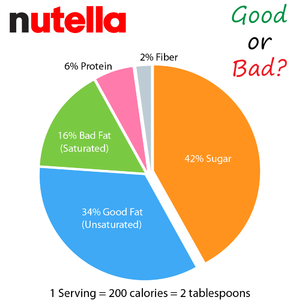
In terms of nutritive qualities, Nutella (per serving (2 Tbsp)) contains 200 Calories, approximately the same as your average granola bar [3]. A Calorie refers to a dietary calorie; approximately, it is the amount of energy needed to raise the temperature of one kilogram of water by one degree Celsius [18]. 200 Calories is one-tenth of the total caloric intake that percentage values are based off of when calculating the percent daily intake values of each nutrient. It is important to note, however, that daily Caloric requirements are going to highly differ between individuals based on activity level, weight, age and height. With this in mind, consumption of Nutella will vary among individuals. However, seeing as Nutella does provide essential nutrients, vitamins, and minerals, it can potentially be part of a balanced diet (if consumed in moderation).
Nutella contains 11 grams of fat per serving, which contributes 17% of the daily required intake recommended based on a 2000 Calorie diet. Fats are one of the three macronutrients: fats, carbohydrates, and proteins [19]. Although, Nutella contributes 17% of the daily-required intake, paired with a balanced diet, Nutella accomplishes a nutritive role in terms of providing the daily-required fat intake. 3.5 grams comes from saturated fats and 0 grams from trans fats [3]. Fats are a wide group of compounds whose basis is in long-chain organic acids, called fatty acids [19]. More particularly, fats are esters of such organic acids formed with the alcohol glycerol [19]. Poly- and monounsaturated fats constitute the remaining 7.5 grams of fat composition from a single serving of Nutella [3]. Polyunsaturated fats can help reduce bad cholesterol levels in your blood which can lower your risk of heart disease and stroke [20]. They also provide nutrients to help develop and maintain your body’s cells [19].
Cholesterol is a sterol (or modified steroid) and is biosynthesized by all animal cells because it is an essential structural component of animal cell membranes that is required to maintain both membrane structural integrity and fluidity [21]. Fat intake plays an important role in blood-cholesterol levels because LDL, low-density lipoprotein, and total cholesterol levels decrease when calorically replacing carbohydrates with mono and polyunsaturated fats [21]. Also, HDL, high-density lipoprotein, levels are increased. HDL’s are ‘healthy’ lipoproteins that are a beneficial part of the diet while LDL’s are ‘unhealthy’ lipoproteins that are disadvantageous to overall health in terms of diet [21]. Nutella, with majority of its fat contribution per serving (7.5 grams/ 2 tablespoons) being constituted by mono- and polyunsaturated fats (the “good fats”) and paired with its non-existent cholesterol per serving addition (0 mg) has characteristics of being a seemingly nutritious product.
In conclusion, contrary to popular belief, Nutella with regard to Caloric, fat, and cholesterol contribution, can be deemed a healthy processed food product, providing essential dietary requirements while bolstering positive healthy diet aspects when consumed in moderation paired with a balanced diet.
Recipes
Nutella spread is renowned for its great chocolate hazelnut flavor profile. It has amazing applications with baked goods and desserts. But it has also received accomplishments in other alternative realms that may not be expected.
We will discuss three recipes: a Nutella ravioli, Nutella bacon smore, and, lastly, a to-die-for multi-layered Oreo-Pretzel-Nutella brownie.
Nutella Ravioli [22]
First, the Nutella ravioli which has as its ingredients to serve 8, 16 wonton wrappers; 1 egg; 225g of Nutella; 16 mint leaves; granulated sugar; and icing sugar.. Nutella Ravioli is an unexpected Nutella preparation that when described sounds amazing. The following steps are required to prepare and cook the ravioli. First, brush the edges of an individual wrapper lightly with with whisked egg. Next, spoon one tablespoon of Nutella into the centre of the wrapper. Fold the wrapper diagonally in half over the filling and press the edges of the wrapper to seal. Following that, place the ravioli on a baking sheet. Repeat with the remaining wonton wrappers, egg, and Nutella. Add enough oil to a heavy large frying pan to reach a depth of 5cm. Heat the oil over medium heat to 180°C. Carefully add the ravioli to the hot oil and cook until they are golden brown, about 45 seconds per side. Remove ravioli when cooked. Next, Spray the topside of the mint leaves very lightly with nonstick spray. Working with 1 leaf at a time, dredge the coated side of the leaves in sugar to coat lightly. Dust ravioli with icing sugar and decorate with dredged mint leaves. Dust the ravioli with icing sugar. Decorate with the sugared mint leaves and serve.
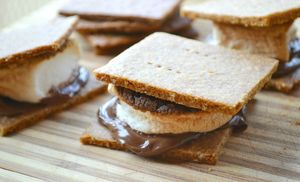
Nutella Bacon S’mores [23]
Nutella bacon smores is a play off of the classic smore but, instead, combines the salty aspects from the bacon paired with the chocolate hazelnut richness from the Nutella, all surrounded by the beloved smore. The Nutella smore consists of two graham crackers per smore, two large marshmallows per smore, 2 slices of bacon per smore, and Nutella. To prepare, spread Nutella over both graham crackers, and top with cooked bacon slices. Next, toast the marshmallows over a camp-fire, barbeque, gas stove, or under a broiler and place on top of the bacon. Finally close the smore with the second graham cracker and there you have it.
Nutella Oreo Brownies [24]
Lastly, the multi layered Nutella brownie. The brownie is composed of an Oreo cookie crust, a prepared Nutella brownie mix, and a pretzel topping. To prepare and cook the brownie, preheat an oven to 350 degrees Celsius. Next, spray non-stick oil in a baking pan and cover the bottom of the pan with Orea cookies. Then, in a mixing bowl, combine ½ cup cocoa powder, ½ cup all-purpose flour, ¼ teaspoon salt, and ½ teaspoon baking powder. In a medium saucepan, melt a ½ cup of butter. Once melted, remove from the heat and whisk in 1cup sugar. Following that, add two eggs, one at a time, while making sure to mix well after each addition. Stir in the ½ teaspoon vanilla extract and 1/3 cup Nutella. Whisk in the dry ingredients with the wet until combined and pour the batter into the prepared pan with Orea cookie base. Lastly, place pretzels on top of the brownie mix to form a crust. When oven is preheated, bake for 35-40 minutes. Allow brownies to cool for at least 45 minutes before frosting with Nutella spread and garnishing with additional pretzels.
Other Applications
Nutella can be used used in an array of delicious desserts but there are alternative uses for the spread. Nutella can be used as a topical treatment, softening skin and treating acne blemishes. There are many reviews of Nutella as a topical treatment ranging from supportive reviews to those who say it doesn’t work. Those who support it say that Nutella is a “great, inexpensive, and yummy face mask to soften your face and get rid of zit flare-ups” [25].
In conclusion, it is evident that Nutella is applicable to all sorts of delicious innovative dessert items. However, it can also be used in alternative unexpected uses such as a topical treatment for the face.
Alternatives
Although Nutella has taken the world by storm, there are some alternatives (just as tasty, but not as popular) that do exist. But before the alternatives are listed, I think it’s safe to say that no alternative can really replace Nutella.
1) Nocciolata
This organic chocolate-hazelnut spread is a great alternative to Nutella. While being organic, it delivers a good ratio between chocolate and hazelnut flavors. Listed below are the ingredients and nutritional values [26].
Ingredients [26]: cane sugar*, hazelnut paste*, sunflower oil*, skim milk powder*, cocoa powder*, cocoa butter*, sunflower lecithin, vanilla extract*
- from organic farming - MAY CONTAIN TRACES OF OTHER NUTS
Nutritional Value (per 2 Tbsp) [26]:
- Calories = 190
- Total Fat = 11g (Saturated fat = 2g, Trans fat = 0g)
- Cholesterol = 0mg
- Sodium = 20mg
- Carbohydrates = 20g (Dietary fibre = <1g, Sugars = 18g)
- Protein = 3g
- Vitamin A and C = 0%
- Calcium = 8%
- Iron = 6%
2) Barefoot and Chocolate Hazelnut Chocolate Spread
This hazelnut-chocolate spread is another good alternative to Nutella. This product boasts several organic ingredients, and delivers a nutty and chocolaty flavor. Listed below are the ingredients and nutritional facts [27].
Ingredients [27]: Organic cane sugar, hazelnuts, palm fruit oil, organic cocoa powder, organic sunflower oil, organic skimmed milk powder, sunflower lecithin, organic vanilla. CONTAINS TREE NUTS AND MILK
Nutritional Value (per 2 Tbsp) [27]:
- Calories = 180
- Total Fat = 13g (Saturated Fat = 2.5g, Trans Fat = 0g)
- Cholesterol = 0mg
- Sodium = 5mg
- Carbohydrates = 14g (Fibre = 1g, Sugars = 14g)
- Protein = 2g
- Vitamin A and C = 0%
- Calcium = 4%
- Iron = 15%
3) Rawmio
This alternative was chosen because it is a healthier option to Nutella. Only natural ingredients are used to make this product, and it provides less than half of the sugar of other alternatives [28]. For individuals that prefer whole, natural foods compared to more processed foods, Rawmio may be the right choice for you!
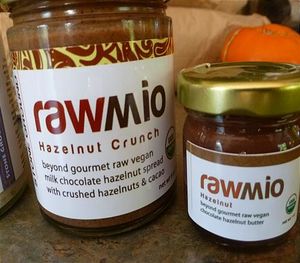
The list of ingredients and nutritional values are listed below.
Ingredients [28]: Raw hazelnuts, raw cacao nibs, coconut sugar
Nutritional Values (per 2 Tbsp) [28]:
- Calories = 170
- Total Fat = 12g (Saturated Fat = 3g, Trans Fat = 0g)
- Sodium = 20mg
- Carbohydrates = 14g (Fibre = 1g, Sugars = 7g)
- Protein = 3g
4) Original Penotti (From Netherlands)
This chocolate-hazelnut spread is from abroad, more specifically from the country of Oranje-Netherlands! A group member has tried this hazelnut spread (before Nutella), and was instantly hooked. It is a great alternative to Nutella, and gives us an idea of what chocolate-hazelnut spread looks like in the Netherlands. Below are the list of ingredients and nutritional values.
Ingredients [29]: Sugar, vegetable oils , hazelnuts (13%), fat reduced cocoa powder (7%), skimmed milk powder (5%), emulsifier (lecithin), natural vanilla flavor. This product may contain other nuts.
Nutritional Values (per 1 Tbsp) [29]:
- Calories = 85
- Total Fat = 5.7g (Saturated Fat = 1.1g, Monounsaturated Fat = 3.2g, Polyunsaturated Fat = 1.2g)
- Sodium = 5mg
- Carbohydrates = 7.6g (Fibre = 0.5g, Sugars = 7.3g)
- Protein = 0.8g
Allergies
Food allergy–induced reactions can sometimes be life threatening, and patients with a food allergy need to receive accurate diagnoses to provide sound preventive measures. Food allergy is typically characterized by a variety of clinical manifestations: anaphylaxis, urticaria-angioedema, flare-up of atopic eczema, rhinitis, asthma, gastrointestinal symptoms, and oral allergy syndrome (OAS) [30].
Sugar (sucrose)/Skimmed Milk (lactose):
Although sugar allergies do not exist, a significant percentage of the population do suffer from some form of sugar intolerance [31]. Sugar intolerance develop when sugar-specific digestive enzymes are, or become, deficient. Patients with such conditions experience diarrhea and inflammation in the gastrointestinal tract after ingestion of sugar (a good example is lactase and lactose intolerance) [31]. Sugar intolerance may develop in several ways, the most common occurrence is genetics (primary) [31]. A secondary way to develop sugar intolerance is an infection of the mucosa layer of the intestinal wall [31]. Since digestive enzymes reside (cell bound) in the intestinal wall, the destruction these tissues will cause the loss of those enzymes, such as the sugar digesting enzymes [31].
Palm Oil:
Palm oil does not seem to be a significant allergen to the general population. Aside from a food ingredient, palm oil can be used medically as a vitamin A supplement for pregnant women [32] . There is some evidence that adding palm oil to the diet of pregnant women and children helps reduce the risk of developing vitamin A deficiency [32]. Palm oil can also act as a coagulant [33]. It may hinder anticoagulant and antiplatelet drug effectiveness if taken coherently, in large amounts [33].
Hazelnut:
In the group of tree nuts, hazelnut has often been implicated as causing allergic reactions. Because the pathogensis-related protein in birch is homologous to hazelnut, allergy to hazelnut is particularly frequent in subjects with respiratory allergy to the pollen of birch, hazel, and alder [34]. Symptoms of an allergic reaction after hazelnut ingestion include itching, burning, and swelling in the mouth and throat (OAS) [34]. In severe cases, urticaria (hives), angiodema (swelling of the lips and mouth), vomiting, diarrhea, and even anaphylaxis may occur [34]. This allergy is most common reaction among tree nut allergies [34].
Cocoa Solids:
Cocoa solids (powder) is not known to cause any type of allergic reactions. In contrast, a component found in cocoa powder is thought to be anti-inflammatory and have an abundance of health benefits. Flavonoids are a class of secondary metabolites found in fruits and plants [35]. Of the six flavonoid compounds, one is found in cocoa – flavonol [35]. Several studies have correlated flavonol, a large proportion of cocoa beans, to antioxidant, anti-inflammatory, and anti-coagulation functioning [36]. This in turn improves cardiovascular health by decreasing blood pressure, reducing blood lipid levels, and insulin resistance [36]. Although abundant in cocoa beans, processing the beans causes the loss of flavonol content within them. Typically, only about 10% of the original amount is retained in cocoa solids [35].
Skimmed Milk:
There are two main allergens in milk and dairy products, these are the proteins casein and whey [37]. A reaction may be activated by one or both of these proteins, the symptoms of such reactions may include vomiting, urticaria, asthma, itchy skin rash, diarrhea, coughs, runny nose and watery eyes, and abdominal cramps [37]. Milk and milk products are the third most common food to cause anaphylaxis, behind only peanuts and tree nuts, respectively. It is the most common food allergy in children and infants, affecting 2-3% of the general population [37].
Video
The video below showcases how to prepare one of the Nutella recipes listed above, while also providing you with fun facts and important information. Hope you enjoy!
Reflection
Even though Nutella has been manufactured since 1964 by Ferraro, it has become increasingly popular within the past couple years, and it is no secret why – the taste is amazing! For several kids and adults, and even the elderly, Nutella is an important part of their breakfast. Many see Nutella as part of a “nutritious breakfast,” and less as an indulgence; however, our group was in agreement that Nutella was more of a dessert than a breakfast. But are the claims made via advertising really true? This group project allowed us to dig deeper and gain further insight regarding this breakfast staple.
Through completion of this project, we were able to better understand the complete manufacturing process of how hazelnuts + chocolate became a breakfast spread. Before the all-famous Nutella spread, Mr. Ferraro sold solid chocolate products in the shape of bread loaves. He thought it would be an ideal way for kids to enjoy their breakfast and get the nutrients they needed. Later, the solid chocolate loaves switched to a more creamy chocolate spread, and it has been that way ever since. However, what surprised most of us in the group was that the first two ingredients were neither hazelnuts nor chocolate; instead, they were sugar and modified palm oil (another word for fat). This got us thinking, and pondering that considering the ingredients, was this item really as “nutritious” as Ferraro claimed it to be?
After digging deeper in regards to Nutella, we were able to realize that although it was considered a processed food, Nutella only contains a handful of ingredients. Albeit the first ingredient is sugar, it does provide a source healthy fats (mono- and polyunsaturated fats) and essential vitamins and minerals (calcium and iron). So, go ahead and enjoy that Nutella that you’ve been eyeing; just remember that just like any other food product, it’s important to enjoy Nutella in moderation and consume it as a part of a balanced diet.
Exam Question
What would you expect to find on the label of a jar of Nutella that is found on the shelf of a Canadian supermarket?
- A diet low in saturated and trans fat reduces the risks of heart disease
- Helps reduce risks of vitamin A deficiency
- Contains hazelnuts, milk, and soy
- All of the above
- None of the above
Answer:
Answer is C, contains hazelnuts, milk and soy. A is a claim allowed by Health Canada, but is not really applicable to Nutella. While B is true for one of the ingredients in Nutella, it is not an allowable claim (yet), so it cannot be printed on the label.
Bibliography
- ↑ 1.0 1.1 1.2 1.3 1.4 Huffington Post: http://www.huffingtonpost.com/Menuism/who-put-hazelnuts-in-my-c_b_4338508.html
- ↑ 2.0 2.1 Caffarel: http://www.caffarel.it/en/home.php?s=0,2,65&dfa=do396&dfm=search&pg=1&g0=1826
- ↑ 3.00 3.01 3.02 3.03 3.04 3.05 3.06 3.07 3.08 3.09 Nutella Canada: http://www.nutella.ca/history.php
- ↑ 4.0 4.1 http://www.historyandwomen.com/2008/03/nutella-unbeatable-decadence.html
- ↑ Health Canada: http://www.hc-sc.gc.ca/fn-an/securit/addit/index-eng.php
- ↑ Nutella FAQS: http://www.nutella.ca/faq.php)
- ↑ 7.0 7.1 7.2 7.3 7.4 7.5 Nutella Wikipedia: http://en.wikipedia.org/wiki/Nutella
- ↑ 8.0 8.1 8.2 Nutella Australia: http://www.nutella.com.au/company/
- ↑ 9.0 9.1 9.2 Nutella Youtube Video: https://www.youtube.com/watch?v=1dwbgruOt6g
- ↑ 10.0 10.1 10.2 10.3 10.4 PET Youtube Video: https://www.youtube.com/watch?v=sjc-f9U6pvo
- ↑ 11.0 11.1 Canadian Food Inspection Agency: http://www.inspection.gc.ca/food/labelling/food-labelling-for-industry/labelling-requirements-checklist/eng/1393275252175/1393275314581
- ↑ Competition Bureau: http://www.competitionbureau.gc.ca/eic/site/cb-bc.nsf/eng/01248.html#sec2.4
- ↑ 13.0 13.1 Health Canada: http://www.hc-sc.gc.ca/fn-an/pubs/securit/2012-allergen_treenuts-noix/index-eng.php
- ↑ 14.0 14.1 Eat By Date: http://www.eatbydate.com/other/condiments/how-long-does-nutella-last-shelf-life/
- ↑ 15.0 15.1 Nutella Food Service: http://www.nutellafoodservice.com/About/Tips/
- ↑ Nutella Blog: http://www.meghantelpner.com/blog/5-reasons-nutella-should-be-banned-from-your-breakfast-table/
- ↑ 17.0 17.1 Least Processed Foods and Their Value: http://fitnesstogether.com/our-solution/fitness-tips/what-is-a-good-rule-of-thumb-when-purchasing-healthy-food-the-fewer-ingredients-the-better/#sthash.qjDVkjuR.dpuf
- ↑ Calorie: http://en.wikipedia.org/wiki/Calorie
- ↑ 19.0 19.1 19.2 19.3 Fat: http://en.wikipedia.org/wiki/Fat
- ↑ Polyunsaturated Fats: http://www.heart.org/HEARTORG/GettingHealthy/NutritionCenter/HealthyEating/Polyunsaturated-Fats_UCM_301461_Article.jsp
- ↑ 21.0 21.1 21.2 Cholesterol: http://en.wikipedia.org/wiki/Cholesterol#Dietary_sources
- ↑ Nutella Ravioli: http://www.foodnetwork.co.uk/recipes/chocolate-hazelnut-ravioli-4224.html
- ↑ Nutella Bacon S’mores: http://www.dianeabroad.com/2012/09/speculoos-nutella-candied-bacon-smores/
- ↑ Nutella Oreo Brownie: http://bakingdom.com/2012/04/nutella-pretzel-brownies.html
- ↑ Nutella On Your Face: http://msbasicbeauty.blogspot.ca/2012/11/nutellaon-your-face.html
- ↑ 26.0 26.1 26.2 Nocciolata Spread: http://www.nocciolatausa.com/
- ↑ 27.0 27.1 27.2 Barefoot and Chocolate Spread: http://www.barefootandchocolate.com/products/hazelnut-chocolate-spread/
- ↑ 28.0 28.1 28.2 Rawmio Spread: http://rawmio.com/products/chocolate-hazelnut-butters
- ↑ 29.0 29.1 Penotti Spread: http://www.penotti.nl/en/penotti-original/penotti-original-400-gram/150
- ↑ Food Allergy: C Bruijnzeel-Koomen, C Ortolani, K Aas, C Bindslev-Jensen, B Bjorksten, D Moneret-Vautrin, et al (1995). EAACI Position Paper: Adverse reactions to food. Allergy, 50: 623–635
- ↑ 31.0 31.1 31.2 31.3 31.4 Sugar and Lactose Allergies: H. A. Weijers and J. H. Van De Kamer (1962). Diarrhoea Caused by Deficiency of Sugar-Splitting Enzymes. Acta Paediatrica. 51(3): 371-374
- ↑ 32.0 32.1 Palm Oil Allergy: Georg Lietz, C Jeya K Henry, Generose Mulokozi, Joseph KL Mugyabuso, Angelina Ballart, Godwin D Ndossi, Wilbald Lorri, and Andrew Tomkins (October 2001). Comparison of the effects of supplemental red palm oil and sunflower oil on maternal vitamin A status. American Journal for Clinical Nutrition, 74(4): 501-509
- ↑ 33.0 33.1 Palm Oil Allergy 2: E. Fattore and F. Fanelli (2013). Palm oil and palmitic acid: a review on cardiovascular effects and carcinogenicity. International Journal of Food Sciences and Nutrition, 64(5): 648-659
- ↑ 34.0 34.1 34.2 34.3 Hazelnut Allergy: C Bruijnzeel-Koomen, C Ortolani, K Aas, C Bindslev-Jensen, B Bjorksten, D Moneret-Vautrin, et al (1995). EAACI Position Paper: Adverse reactions to food. Allergy, 50: 623–635
- ↑ 35.0 35.1 35.2 Cocoa Solids Allergy: Corti, R.; Flammer, A.J.; Hollenberg, N.K. (2009). Cocoa and Cardiovascular Health and Circulation. Contemporary Reviews in Cardiovascular Medicine, 119: 1433–1441
- ↑ 36.0 36.1 Cocoa Allergies: Nasiruddin Khan, Olha Khymenets, Mireia Urpí-Sardà, Sara Tulipani, Mar Garcia-Aloy, María Monagas, Ximena Mora-Cubillos, Rafael Llorach, Cristina Andres-Lacueva (February 2014). Cocoa Polyphenols and Inflammatory Markers of Cardiovascular Disease. Nutrients, 6: 844-880
- ↑ 37.0 37.1 37.2 Milk Allergy: Justin M. Skripak, Elizabeth C. Matsui, Kim Mudd, Robert A. Wood (November 2007). The natural history of IgE-mediated cow's milk allergy. Journal of Allergy and Clinical Immunology, 120(5): 1172-1177